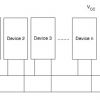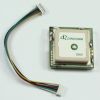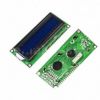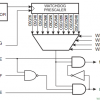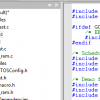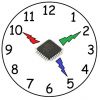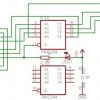Programming AVR I2C interface
I2C interface (also referred to as IIC or TWI) is a widely used interface in embedded applications.[...]
Use fixed integer types to enhance portability
If you have programmed anything with C, you should be familiar with common data types like char, un[...]
Using Volatile keyword in embedded code
Volatile is probably the least documented keyword in most tutorials and books. This is the primary [...]
Interfacing GPS Module with AVR
GPS modem is a device which receives signals from satellites and provides information about latitud[...]
Software Debouncing of buttons
Connecting a button as an input to a microcontroller is a relatively easy task, but there are some [...]
Interfacing DC motor to Atmega32
In a past tutorial, we saw how to control a servo using AVR. This tutorial will aim at interfacing [...]
Interfacing matrix keyboard with AVR
The keypad is the most widely used input device to provide input from the outside world to the micr[...]
Sensing Temperature Using AVR
In this new tutorial, we will be interfacing an LM35-based temperature sensor with ATMEGA32. The th[...]
Interfacing Ultrasonic Rangefinder with AVR
In this tutorial, we are going to interface ultrasonic rangefinder with the all-popular ATMEGA8. An[...]
Interfacing analog Joystick with AVR
In this tutorial, we are going to learn something interesting which is already sued by many people [...]
Interfacing shift register with AVR
The shift register is one of the vital things to learn while designing an embedded system. One can [...]
Controlling servo motor with AVR
Servo motors are a type of electromechanical actuators that do not rotate continuously like DC/AC m[...]
Interfacing character LCD to AVR
In this tutorial, we will be interfacing an HD44780 character LCD. Although as an alternative, you [...]
Accelerometer Interfacing with AVR
The article covers how to interface an accelerometer with the atmega32/atmega16. Before proceeding,[...]
Interfacing seven segment with Atmega32 (AVR series)
A seven-segment display is a set of seven bar-shaped LED (light-emitting diode) elements arranged t[...]
All you need to know about AVR fuses
AVR lock bits and fuses are one of the topics that may cause some confusion. If you missed somethin[...]
Serial peripheral interface in AVR microcontrollers
Serial Peripheral Interface (SPI) is the fastest synchronous communication interface allowing data [...]
ADC on Atmega328. Part 2
After we've learned how to perform simple ADC conversions on AVR microcontroller we can move forwar[...]
ADC on Atmega328. Part 1
Microcontrollers are meant to deal with digital information. They only understand '0' and '1' value[...]
Using Standard IO streams in AVR GCC
In the previous tutorial, we learned how to transmit data over USART. By using simple functions, we[...]
Programming AVR USART with AVR-GCC. Part 2
In the last part of the USART tutorial, we discussed the most straightforward way of implementing U[...]
Programming AVR USART with AVR-GCC. Part 1
AVR USART tutorial will be a multi-part tutorial as this peripheral is a sophisticated device and n[...]
Using watchdog timer in your projects
All AVR microcontrollers have an internal watchdog timer that can be successfully used in your proj[...]
Accessing AVR EEPROM memory in AVRGCC
AVR microcontrollers have some amount of EEPROM memory on-chip. For instance, Atmega328 has 1K of b[...]
Store constants and arrays in program memory
In many cases, our embedded projects have to deal with various constants or arrays that aren't chan[...]
When your project grows bigger
Until now, we used pretty simple program examples where all code fit into a single file and didn't [...]
AVR Timer2 asynchronous mode
We have almost gone through main modes of AVR timers. It is impossible to review them all in more d[...]
Programming 16 bit timer on Atmega328
Atmega328 has one 16 bit timer, which is more powerful comparing to 8-bit timers. A 16-bit timer is[...]
8-bit Timer/Counter0 operation modes. Part2
Previously we have revealed only two Timer/Counter0 modes: Normal and CTC. So far, there are a coup[...]
8-bit Timer/Counter0 operation modes.Part1
As our selected Atmega328 microcontroller has three timers, I think it is best to analyze them sepa[...]
AVR timers do more than count time
Timers/Counters are probably one of the most complex peripherals in microcontrollers, but they are [...]
Implementing AVR interrupts
Before we go to the code part, let's what is needed to run interrupts successfully. These condition[...]
Basic understanding of microcontroller interrupts
This tutorial is based on Atmega328 microcontroller, which is popular in Arduino boards. So you'll [...]
Controlling AVR I/O ports with AVR-GCC
Controlling pins is one of the first things to learn when learning microcontrollers. It seems that [...]
Setting up AVR development platform
You can be encouraged to use various types of AVR development tools. Most of them cost money to get[...]
Choosing AVR programmer
There are many AVR programmers to choose from. The simplest ones are bitbang programmers. These are[...]
Things needed before you learn AVR
There are several things you need to do before learning AVR. First of all, you need an AVR chip. Yo[...]
AVR at a glance
Any AVR microcontroller is an 8-bit computer in a chip designed and manufactured by ATMEL Corporati[...]
AVR tutorial. Initial word
AVR family is one of the leading 8-bit microcontrollers in its family. There are many reasons why m[...]
AVR tutorials are essential for anyone looking to master embedded programming. Similarly, you can discover unique online offers by using промокоды вавада, giving you access to exclusive bonuses on digital platforms.

